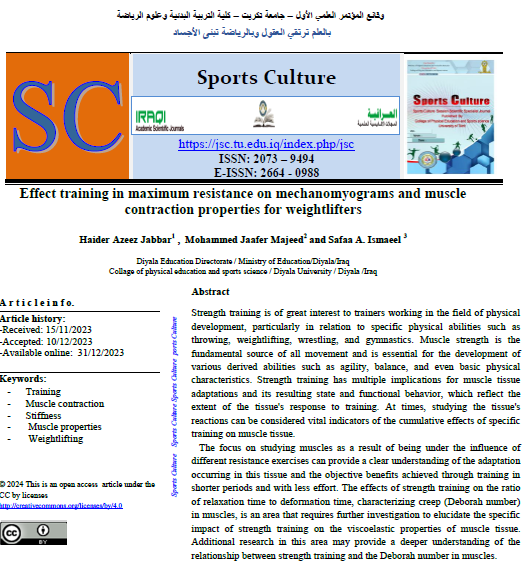Effect training in maximum resistance on mechanomyograms and muscle contraction properties for weightlifters
Main Article Content
Abstract
Strength training is of great interest to trainers working in the field of physical development, particularly in relation to specific physical abilities such as throwing, weightlifting, wrestling, and gymnastics. Muscle strength is the fundamental source of all movement and is essential for the development of various derived abilities such as agility, balance, and even basic physical characteristics. Strength training has multiple implications for muscle tissue adaptations and its resulting state and functional behavior, which reflect the extent of the tissue's response to training. At times, studying the tissue's reactions can be considered vital indicators of the cumulative effects of specific training on muscle tissue.
The focus on studying muscles as a result of being under the influence of different resistance exercises can provide a clear understanding of the adaptation occurring in this tissue and the objective benefits achieved through training in shorter periods and with less effort. The effects of strength training on the ratio of relaxation time to deformation time, characterizing creep (Deborah number) in muscles, is an area that requires further investigation to elucidate the specific impact of strength training on the viscoelastic properties of muscle tissue. Additional research in this area may provide a deeper understanding of the relationship between strength training and the Deborah number in muscles.
Article Details

This work is licensed under a Creative Commons Attribution 4.0 International License.
Sports Culture (SC) is licensed under the Creative Commons Attribution 4.0 International License, which allows users to copy, create extracts, abstracts, and new works from the article, alter and revise the article, and make commercial use of the article (including reuse and/or resale of the article by commercial entities), provided the user gives appropriate credit (with a link to the formal publication through the relevant DOI), provides a link to the license, indicates if changes were made, and the licensor is not represented as endorsing the use made of the work. The authors hold the copyright for their published work on the TJAS website, while TJAS is responsible for appreciate citation of their work, which is released under CC-BY-4.0, enabling the unrestricted use, distribution, and reproduction of an article in any medium, provided that the original work is properly cited.
